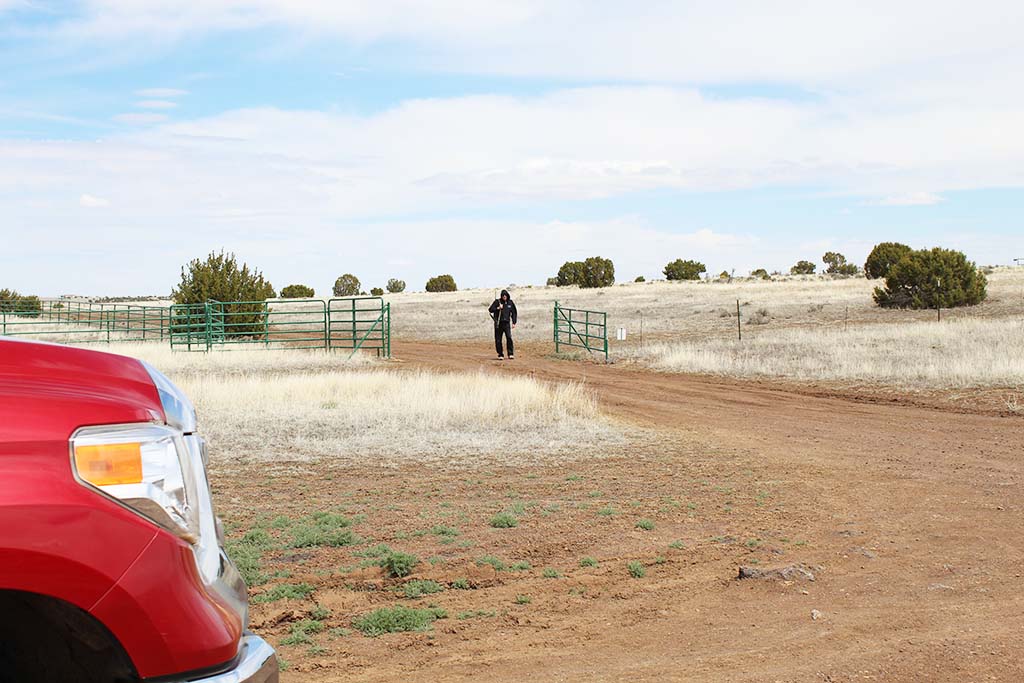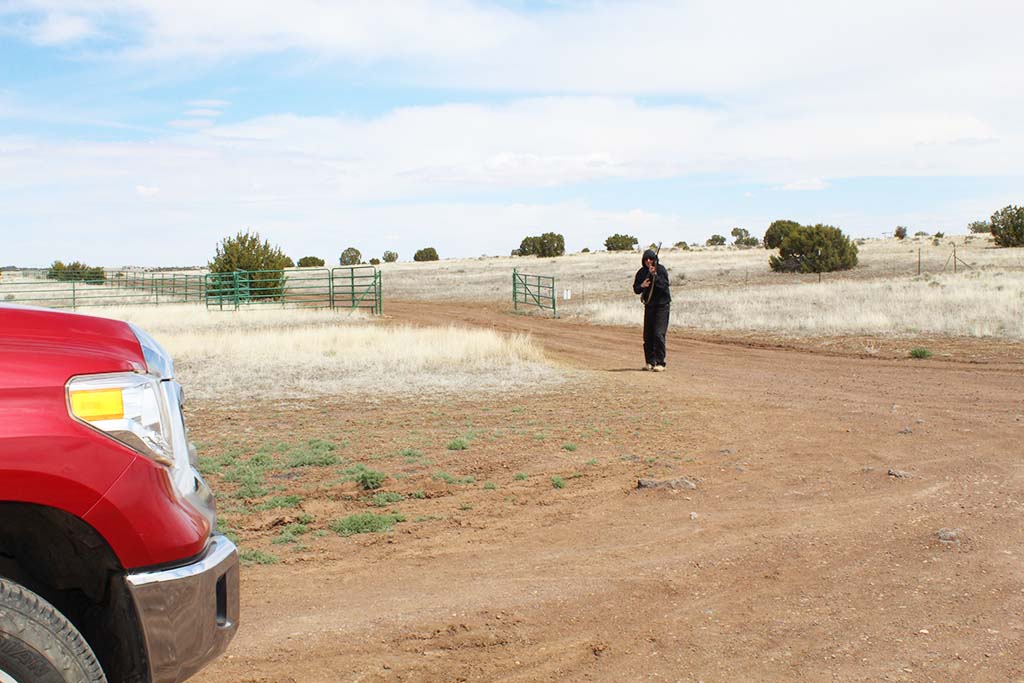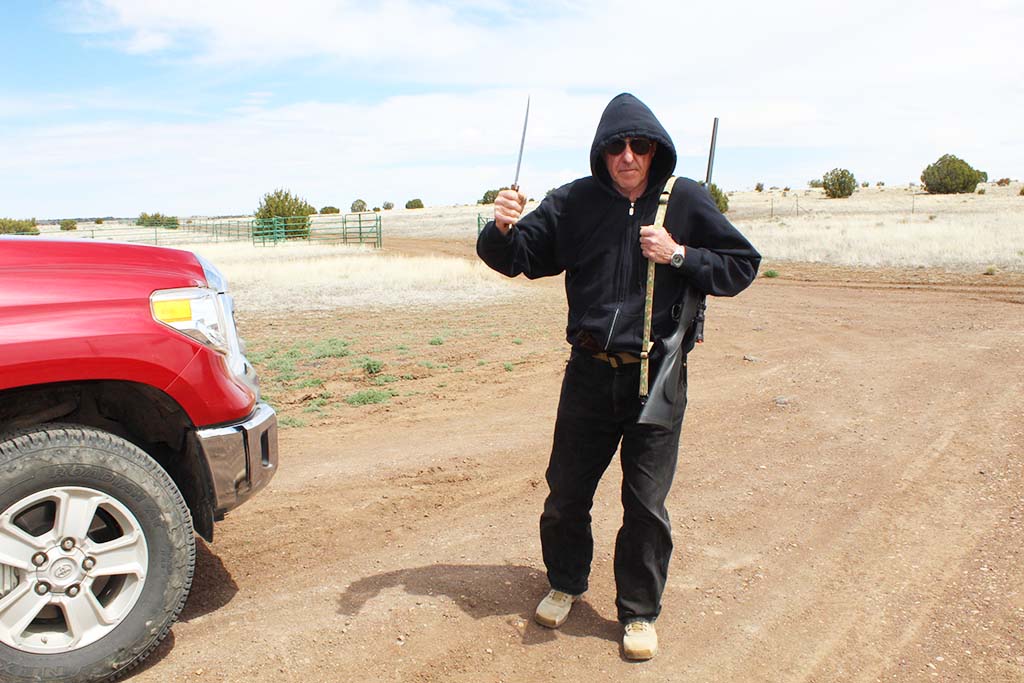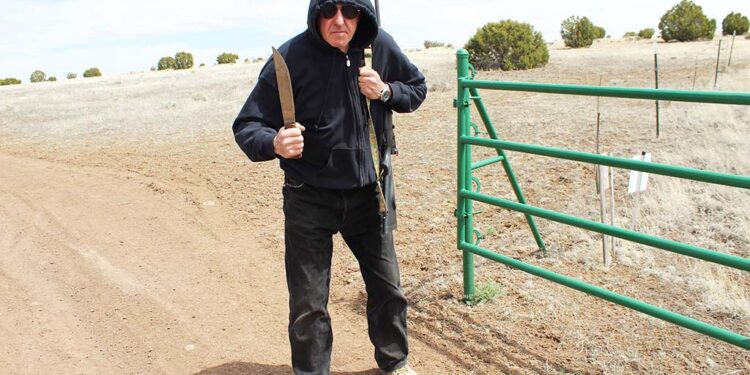Flee If You Can, but Fight If You Must
By Linda M. Gilbertson

THE SITUATION
Springtime is when those of us who live in the Southwest United States start looking a little closer at everything that is on the ground. We watch for anything that moves. The diamondback rattlesnake is a resident of Arizona. It makes its way to the surface from its winter hiding place when temperatures rise. It’s looking for warmth and food. It will be hungry and angry if it has been a particularly long and cold winter. The snake is stealthy in nature, and if you tread too close, it will let you know it’s present. The rattle is distinct and gives you the chance to change directions before it strikes. Flight is the best answer.
Fight is also a good choice should this snake endanger you and anyone or anything nearby. I’ve almost stepped on one, because it was stretched across the gravel driveway taking in the sun. I couldn’t distinguish it from the roadway. It blended in with its environment. A snake encountered accidentally, won’t always rattle as it bathes in the sun’s warmth. When I encounter a rattlesnake, I take a shovel to its head, decapitate and bury it. Once I chased a rattlesnake from one side of a shed to the other and finally ended it with the snake-shot from a Charter Arms .44 Special Bulldog. Fight is the best answer.
THE DILEMMA
Now you may ask why I didn’t leave the snake alone that was under my shed. The simple answer is that a snake procreates. Even though our dogs have the rattlesnake vaccine on board, it does not protect them from being bitten. The vaccine only slows down the absorption of the venom until you can get them to the veterinarian. There is yet no rattlesnake vaccine for humans as a preventive. There is only the expensive treatment after humans have been bitten. I keep snakes away from my house so my husband, I and the dogs don’t get bitten. I must fight in this situation to control the rattlesnake population. Most of us are raised with a fear of snakes because we’re educated from infancy to be aware of and be prepared with a response to seeing or hearing them. We’re taught to avoid their territory. Also, the appearance of a venomous snake is constant. It doesn’t change clothing, it doesn’t walk upright, and it is predictable during certain seasons. The rattle is distinct and makes you hesitate. You fear the bite, which can kill.
An “active shooter” situation is very similar to an encounter with a rattlesnake. The shooter is silent, conniving, venomous and deadly. The shooter is hungry. Unfortunately, in our current culture, people rarely have heightened awareness of those two-legged snakes. Active shooters come in different colors, wear different clothing and are active all season long. With society’s need for “profile-less” encounters, people are told not to base a belief of a person on his or her physical appearance or behavior. The human rattlesnake is to be accepted whether a danger or not. Look at the school shootings that have taken place. The human rattlesnake was detected but not reported. It was tolerated. Acceptance of these snakes’ peculiarities (because society says we need to accept everyone’s peculiarities) leads to denial of any danger, and many times, that’s too late!
THE FLIGHT THEORY
In The Gift of Fear by Gavin De Becker, survival skills protect us from violence. The main skill is intuition. It is a skill which is undeveloped in many people because they’ve become lazy in their own personal protection. Society tells people to deny basic survival skills and that responding to the threat will get them in trouble because they’re not competent to respond appropriately. In his book, Gavin De Becker is adamant that we need to pay attention to the following messages and heed what our “natural animal” mind is telling us. These are called the “Messengers of Intuition.” These 13 messengers are telling you something about the person(s) or the situation(s):
• Nagging feeling
• Persistent thoughts
• Dark humor
• Wonder
• Anxiety/fear
• Curiosity
• Hunches
• Gut feelings
• Doubt
• Hesitation
• Suspicion
• Apprehension
Pay attention to your intuition if any of these feelings have you questioning what is occurring. If you can avoid and flee from the situation, do so. As an example, I went into a restaurant and could not eat there. It was a matter of something that told me I couldn’t remain. I don’t know if it was the smell, the color or whether someone inside the restaurant said or did something, but I became anxious. I couldn’t articulate what it was, but I could not remain. I have no idea whether anything happened after I left—I chose flight.
THE FIGHT THEORY
Lori Hartman Gervasi is an expert in martial arts and the author of Fight Like a Girl and Win. In her book she explains her view on fighting:
• Don’t just stand there and allow initial threats by suspicious people.
• Do react when anyone tries to close in on you in a physical or relational manner.
• Do consider his/her attitude and reactions as clues to what may happen next.
• Don’t wait. Get moving and gain back your distance.
I was standing in line at Kmart one day. There were two people in front of me and two people behind me. Of course, all of us are either carrying goods or pushing a cart full of our goods. So, we’re jammed together; everyone has violated personal space. I was very aware of each of these individuals, purposely practicing “awareness.” Suddenly, the second person behind me, a male, started talking inappropriately to the woman in front of him. These comments were of a personal and sexual topic. This continued for approximately one minute. I became annoyed. I turned to look at her, and I saw FEAR in her eyes. I got mad. I squarely faced the man. The woman being shorter than I, gave me a great view of the man behind her. I raised my voice and said to this man, “Leave her alone. She’s not interested.” He said to me, “You’re rude!” I raised my voice a little louder, glared into his eyes and said to him, “Yes, and you’re obnoxious, leave her alone.” Kmart personnel called security. I already knew what I would do in a situation like this, as I had practiced it in my mind. I had visualized my next move which was to exchange places with her (a little hard to do under the circumstances) and put distance between him and her. I went directly from fear to anger. I fought for her not with force, but with voice. In this case a firearm did not need to be displayed, but mine was available if the situation had escalated to physical assault. I was prepared to fight.
When near an active shooter, you must be prepared to fight. You need to be on the offense rather than the defense and take it to the next level if necessary. That’s reality!
THE REALITY
In Arizona if you are in fear for your life or the life of someone else, this is your justification for using deadly force. Deadly force is causing serious bodily injury or death. In most situations, a gun is considered deadly force, but a baseball bat, a knife, a person’s fists, even body size could be considered deadly. Many have been killed by strangulation, by being kicked, punched, tossed on the ground, stomped, knifed, etc., and though not considered deadly force, that’s a matter of opinion. If you fear for your life, no matter the method of force used, you must fight with all your might. So, in an active shooter situation what would make you flee vs. fight? Let’s explain this question with a few pictures.
Is deadly force justified in this situation? In this picture the perpetrator is not a threat to me because of the distance he is from me. However, he’s also carrying a rifle. He’s carrying the rifle, not aiming the rifle. Am I justified in shooting at him at this distance? Will I even hit him with my pistol? How quickly can he run toward me or shift the rifle into a firing position? A court would say that at this distance, I should go to a safe area with my phone and call 911. This would be considered an alternative to engaging the perpetrator in a gun battle. Otherwise the court may say that I was waiting for trouble rather than removing myself to safety. I would flee.

Is deadly force justified in this situation? In this picture the perpetrator is closer and becoming a threat. His rifle is now raised so he may aim at me. Is he accurate enough for his round to hit me? He does have a rifle scope. Do I even want to stick around and find out? I’m in fear for my life since he’s starting to aim at me, and the court would again recommend avoidance by leaving the premise or barricading myself in a room and relying upon 911. I can leave because he’s still at a distance from which I can run. If I hesitate and allow him to get closer, the court may intimate that I was looking for a fight. If I engaged him with shots at this distance, I may not be successful at hitting him, and an innocent bystander may be hit. I would flee, but if I’m in a wheelchair or on crutches, I might have to fight.

Is deadly force justified in this situation? In this picture, the perpetrator is at 10 feet. His rifle is not a threat to me, but the knife is. Do I have the time to avoid or am I in the thick of it? My response is now dependent upon my size and physical ability. I’m not a Black Belt in Karate nor do I have the physical strength for any hand-to-hand combat. I’m not proficient in knife fighting nor am I a track star, so if running is involved, I’ve got a problem. I’ve allowed the perpetrator to get to close to me. He has me at a disadvantage. I’m in fear for my life, and if I don’t respond appropriately, I’ll experience bodily harm or possibly death. The attack must be stopped. My first concern is to stay alive. I will fight to accomplish this. If I choose to utter something to the perpetrator it would be to stop and disarm. I’d take the rifle and knife, call 911 and keep my pistol on him till the police arrive. I can articulate in court that I was in fear for my life based upon the circumstances. The court would probably agree. Or, do I draw and fire? If he doesn’t comply with my orders and continues to advance, I’m justified in using deadly force. I will fight.

THE WRAP-UP
In Arizona, you can “Stand Your Ground” if you have a legal right to be where you are. We also have the Castle Doctrine which says that we don’t have to leave our home when it is invaded. And, it is not required that we utter a verbal warning. The question then becomes, should you fight, and what would make you fight. According to Gavin De Becker, “When you are at imminent risk, intuition forgets about all this logical thought and just sends the fear signal. You are given the opportunity to react to a prediction that has already been completed (by you) by the time it comes into consciousness.” Flight vs. Fight (flee if you can, but fight if you must) is based on the signals you’re receiving. In an active shooter situation, most people are not prepared for trouble, and they become involved in a reactive rather than a proactive response. Fear shuts them down, and they become casualties. Those people who are prepared for trouble and have practiced physically and mentally an offensive response will be the survivors. Whether it is running away or standing and fighting, know the law and be prepared. Franklin Roosevelt said it best, “When you see a rattlesnake poised to strike, you do not wait until he has struck before you crush him.”
| This article first appeared in Small Arms Review V25N3 (March 2021) |












